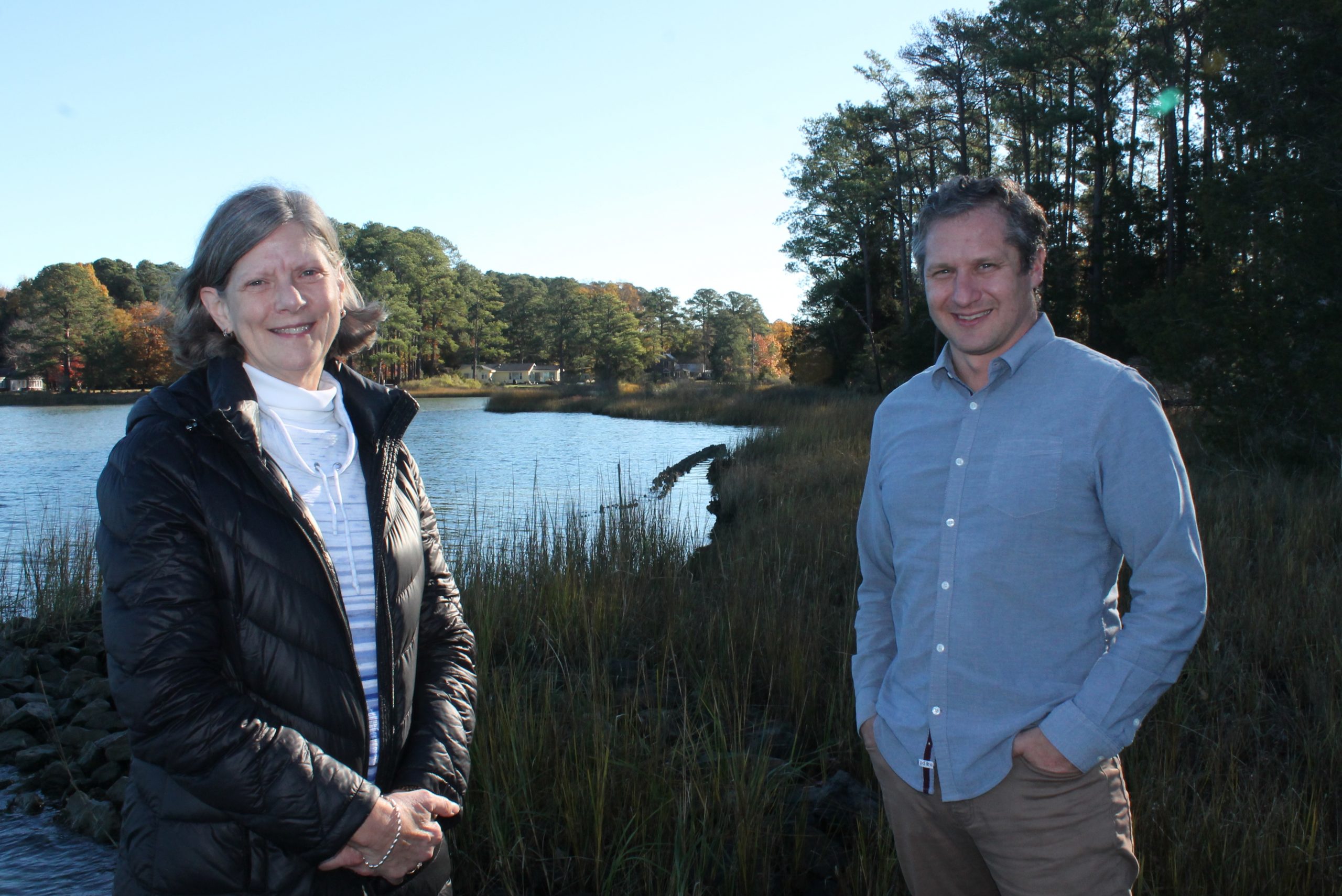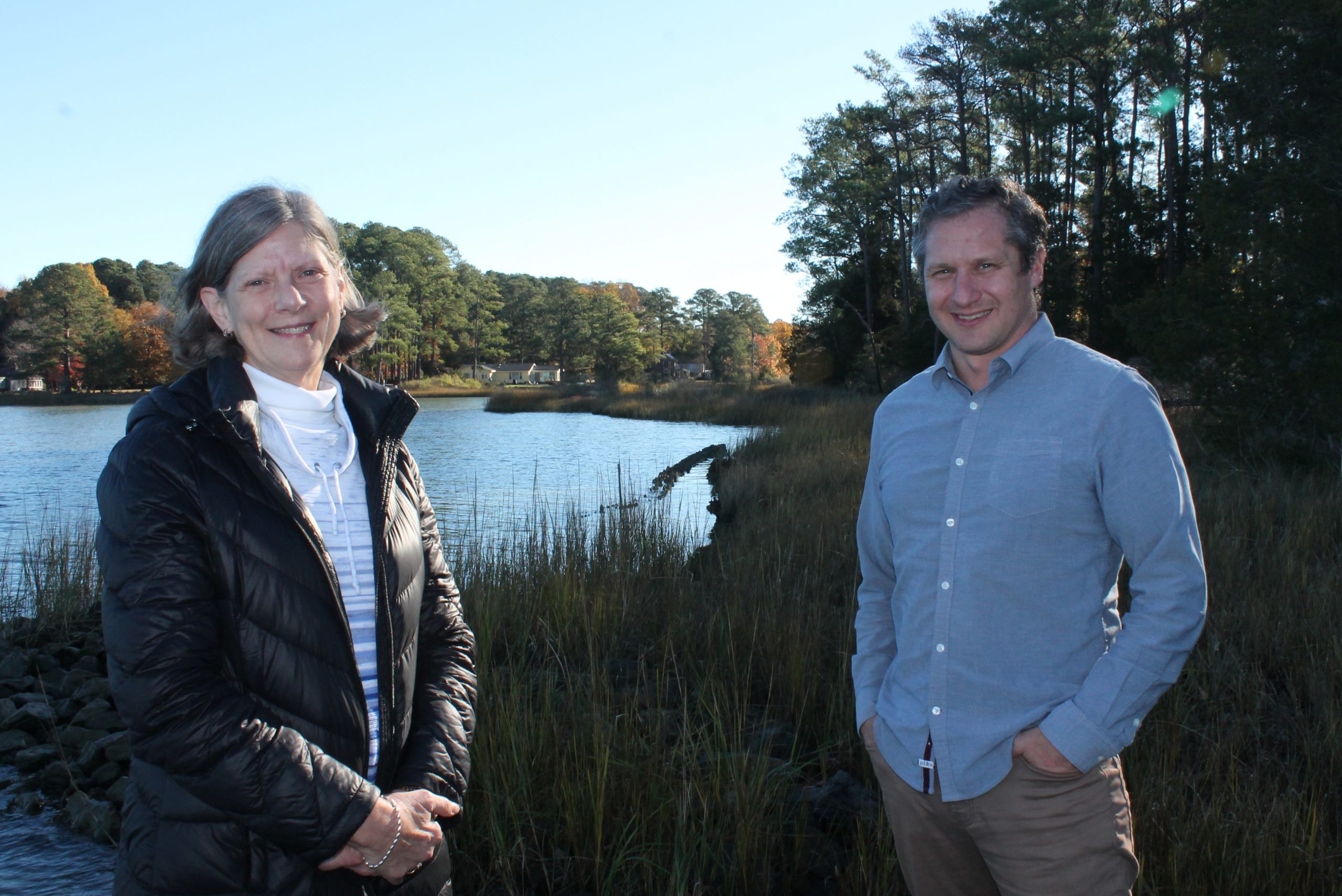A recent living shorelines project we were involved in was just written up in the Gloucester-Mathews Gazette-Journal. This National Fish and Wildlife Foundation grant-funded shoreline project made use of our Natrx ExoForms to combat erosion and provide ongoing coastal resilience. Check it out below:

SHERRY HAMILTON / GAZETTE-JOURNAL Betty Case, left, of Atlanta and Port Haywood received grant funding to help pay for a project to create a living shoreline along her property on the East River. The project uses new technology developed by Matt Campbell, right, president of Natrx Adaptive Infrastructure in Raleigh, North Carolina.
A grant-funded shoreline restoration project in Mathews is using a new technology developed by Natrx Adaptive Infrastructure to help create efficient, effective—and cost-effective—living shorelines.
Betty Case of Atlanta and Port Haywood has a long shoreline at her East River property, and she’s concerned about erosion that’s occurring due to wave action driven by winds coming up from Mobjack Bay.
A shoreline study conducted a number of years ago by Donna Milligan and Scott Hardaway of the Virginia Institute of Marine Science identified Case’s property as one of several sites in Mathews that needed shore protection, so when the Middle Peninsula Planning District Commission secured a National Fish and Wildlife Foundation grant to create a reach-based, resilient shoreline protection project, Case was contacted to see if she wanted to participate. Her answer was an enthusiastic yes.
Natrx is a Raleigh, North Carolina-based company that uses patented computer-based manufacturing to create custom concrete modules expressly designed for the needs of a specific site. President and head of engineering Matthew Campbell said his company focuses on nature-based solutions for coastal restoration. He said he had been in the business of coastal restoration for 20 years, and that “creative desperation” had eventually led him to come up with a system that could “do things more efficiently and effectively.”
He invented a new process for forming concrete, Dry Forming, which is a type of 3D printing with concrete, to develop structures that were a better fit for certain sites than riprap, which requires building a structure with large stones that, pyramid-like, is wider at the bottom than the top.
The exoforms Campbell’s company creates with the technology weigh about 250 pounds each and have rounded edges with rough surfaces and crevices that oysters like, he said. They’re made tall enough to break the waves before they hit the shoreline, but low enough so that sediment can be transported over them during storms. Water is maintained at the same level as the river, providing marsh grasses with proper nourishment. The structures can even be designed to dip lower in some places for fish to cross over, and the openings in them allow water to flow through.
One of the best things about Natrx structures, said Campbell, is that they are more cost-effective than riprap, able to cover two to three times the linear footage than rock for the same price.
“We’re trying to bring new tools to restoration and make the whole industry more efficient,” he said.
Milligan, an associate research scientist in VIMS’s Physical Sciences Department, said the long shoreline at Case’s property has different habitat components that need to be handled differently. The project, which has been about two years in the making, will involve placing Natrx structures in front of areas with existing but eroding marsh grasses to mitigate erosion by breaking the waves before they hit the marshland. Riprap will be placed offshore along high-energy areas that have already eroded, with sand fill behind it for planting grasses. The structures will provide substrate for oysters to grow and “hopefully become a nice oyster reef.”
Campbell said there appears to be a lot of demand for shoreline projects in this area, so he’s considering establishing a manufacturing site here as the demand for his product grows. Lewie Lawrence, director of the Middle Peninsula Planning District, said that the Captain Sinclair Lewis property in Gloucester that’s being managed for the county by the Middle Peninsula Public Access Authority would be a good potential location for manufacturing the Natrx modules.
Case said she’s thrilled at the expertise that’s being brought to her shoreline project and happy to be “an example in this area of what can be done.”
--
You can read the original article here.


